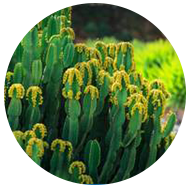Surviving flora
Although the island of Fuerteventura was never covered by forests, before the first human beings arrived there was more vegetation than we see today. The extensive cattle raising and agriculture, the collection of firewood for the homes and the hundreds of lime kilns that were in operation on the island have made most of its trees and plants disappear.
These circumstances, together with the island’s characteristics, make it quite easy for anyone to guess what one of the most common plants in Fuerteventura may be: the cactus.
Endemic species
Fuerteventura has a dozen endemic plants that can only be found on this island, such as the Jandía spurge, which you will find in our garden. You will also be able to see barrel cactuses, such as the “mother-in-law’s cushion”, and column cactuses, which can become really huge.
In addition to being surrounded by species that are endemic to Fuerteventura, you can also find cactuses from other parts of the world.









